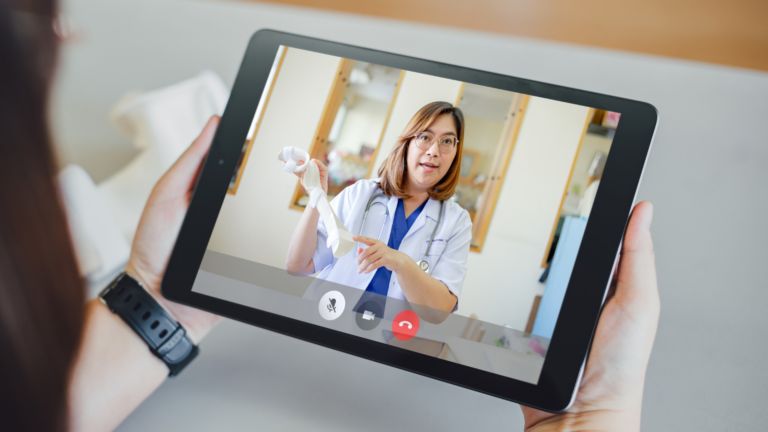- By Mercy Akinbinu, RN, BSN
Today, people use the internet for a range of purposes, from entertainment to finding cooking recipes and keeping up with international news. Healthcare is no exception; for example, you might have looked up symptoms to determine why your body hurts.
It is common knowledge that giving people access to accurate information on a topic at the right time can significantly affect their decision-making. When used correctly, healthcare businesses can use content to inform diverse audiences about various healthcare solutions.
This blog post will explore the meaning of content in healthcare and how it may inform a variety of people about healthcare solutions. We’ll examine the kinds of information businesses can use in healthcare content and how it can affect thoughtful decisions.
But First, What is Healthcare Content?
Healthcare content is a form of content that provides information based on health-related topics. It may be in various formats, for example, written, interactive, visual, or audible.
Healthcare content can cover many subjects, from overall well-being to specific medical diseases, treatments, and procedures. Patients themselves, patient advocacy groups, healthcare organizations, and medical professionals like nurses can all create it.
Why is It Critical to Consider Audience Diversity When Creating Healthcare Content?
To provide the most accurate information to various patient populations when designing healthcare content, healthcare organizations must consider audience diversity.
Audiences vary depending on a variety of criteria, including but not limited to the following:
- Age
- Location
- Language
- Interests
- Health status
What are the Types of Healthcare Solutions That Content Can Help to Educate Different Audiences About?
Healthcare solutions are accessible resources provided at the right moment in a way that is engaging and easy to understand to affect a positive shift in health behavior. It consists of several formats appropriate for a variety of audiences.
Patient Education
Patient education is a method of influencing patient behavior by giving them pertinent information. It aids in supporting and facilitating patients’ efforts to learn more about options related to their health, well-being, and medical treatments. Patient education empowers patients to acquire a sense of autonomy, stimulates better health results, and fosters better healthcare satisfaction because educated medical experts typically administer it.
Health Promotion
According to the World Health Organization (WHO), health promotion is the process of empowering people to exert more control over and improve their health. It strives to assist people in achieving health literacy to improve overall health and promote the management or prevention of chronic illnesses.
Disease Awareness
Understanding a medical condition well in advance can prevent diseases’ serious effects. This preparation is disease awareness. You are more likely to take preventative action and go for screenings, testing, and check-ups if you are aware of a condition and its symptoms.
Healthcare Provider Education
Healthcare provider education is the training that healthcare professionals undergo to keep their knowledge and skills on illness prevention (and management) up to date. This process enables medical professionals to give the greatest patient-centered care by informing them of recent developments in their fields or specialties.
Patient Engagement
This healthcare solution is the desire and capacity to actively participate in care in a way that is particularly relevant to the individual, in collaboration with a healthcare practitioner or institution, to maximize improvement or improve care experiences.

Effective Ways to Use Content to Educate Diverse Audiences on Healthcare Solutions
To provide content to various audiences, healthcare organizations must comprehend their needs and preferences and adjust the content accordingly. The following are some efficient strategies for delivering material to diverse audiences:
Define Your Target Market
Before producing content, it’s crucial to determine the target market and consider factors like gender, age, level of education, and geographical area. Investigate further to discover what material they are reading and what they desire as you create personas and ideal client profiles. You can segment your viewers using the answers to create content appropriate to their needs, interests, and beliefs.
Determine the Purpose
Another technique to use content effectively for spreading information about healthcare solutions is to determine the content’s purpose. The primary content types include announcements, news events, and educational and informational content.
Choose the Right Format
The intended audience should guide your choice of format. Younger consumers might like social media updates or videos, while older audiences may prefer printed materials like leaflets or email newsletters.
Provide Relevant Information
This step involves ensuring your target audience receives information that meets their needs and improves health literacy. For example, you may write a blog about proper care of wounds for patients diagnosed with Diabetes Mellitus.
Use the Right Language
Communicating using simple, understandable phrases rather than medical jargon facilitates the effective dissemination of information. Additionally, you can utilize visuals like pictures and films to simplify complicated concepts.
Limit Biases to a Minimum
The perspective through which we view the world influences everything we write. Strive for objectivity by avoiding generalizations and delivering evidence-based writing to aid in reducing biases from being displayed in healthcare content.
Be Consistent
This expectation requires keeping a regular schedule to provide relevant and engaging information. Consistency can encourage prospective clients to use your healthcare service and return for more. Additionally, it can help establish your credibility, trustworthiness, and reputation.
Get Feedback
By requesting audience feedback, you can enhance your content and get suggestions for topics your audience may be interested in learning more about. You may use social media polls or surveys to get your audience’s feedback.
How Does Content Help Educate Diverse Audiences About Healthcare Solutions?
To raise awareness of various healthcare solutions to diverse audiences, organizations can employ the following types of content:
- Health articles and blog posts
- Videos and podcasts featuring medical experts discussing health topics
- Infographics and other visual aids that break down complex medical concepts
- Medical research studies and reports
- Interactive quizzes and tools to help individuals assess their health risks or track their symptoms
- Patient education materials such as leaflets, brochures, or pamphlets
Potential Benefits of Using Content to Educate Different Audiences on Healthcare Solutions?
In various ways, content can be highly beneficial in teaching different people about healthcare solutions.
Giving Correct and Current Information
Content can provide accurate and trustworthy information on various healthcare solutions, educating audiences on recent drugs, techniques, and treatments.
Limiting the Complexity of Medical Terminology
Healthcare is awash with medical jargon and complicated phrases, so the content may help people understand these terms by translating them into simple and accessible vocabulary.
Addressing Common Health Issues
Content can address frequent healthcare issues and offer guidance on handling them. For instance, an article might include advice on performing cardiopulmonary resuscitation (CPR) or maintaining a healthy diet.
Showcasing Success Stories
People can learn more about the advantages of healthcare solutions by watching or reading the success stories of patients who have undergone healthcare treatments. This process can reassure people and encourage them to get the proper medical care.
Offering Interactive Resources
Interactive materials like infographics, quizzes, and videos can engage various audiences and give them a fun approach to learning about healthcare solutions.
Final Thoughts
Millions of individuals look for health and medical information online, and most, if not all, healthcare companies and practices use content techniques to teach their clients about services and treatment options. Users will be more confident in your services if you consistently deliver relevant and high-quality information, which will also help you establish trustworthiness and maintain authority among your competitors.
A thriving healthcare content marketing strategy requires expertise and knowledge because it is a long-term, continuous task. Thankfully, you don’t need to go it alone. You can concentrate on what matters most to you and your healthcare business by working with our team of experienced nurse writers to help you meet your content marketing objectives.
Expert nurse writers can help your healthcare company grow by creating content that promotes the brand’s values and provides valuable information to present and potential customers.
References
Beveridge, C. (2022, October 11). How to Use Social Media in Healthcare: Examples + Tips. Hootsuite. https://blog.hootsuite.com/social-media-health-care/
Higgins, T. E., Larson, E., & Schnall, R. (2017). Unraveling the meaning of patient engagement: A concept analysis. Patient Education and Counseling, 100(1), 30–36. https://www.sciencedirect.com/science/article/abs/pii/S0738399116304098?via%3Dihub
Koumadoraki, A., & Koumadoraki, A. (2022, September 21). 6 Benefits of Patient Education & How to Educate Patients. LearnWorlds. https://www.learnworlds.com/patient-education/#benefits
Riserbato, R. (2021, October 27). 10 Benefits of Consistent, High-Quality Content Marketing. Hubspot. Retrieved May 17, 2023, from https://blog.hubspot.com/marketing/benefits-high-quality-content-consistency-brand
Solopova, T. (2023, April 20). Healthcare Content Marketing. Customer Think. https://customerthink.com/healthcare-content-marketing/
University of Arkansas. (2023, April 11). Confronting Bias. https://uark.libguides.com/bias/writing
World Health Organization. (n.d.). Health Promotion. https://www.who.int/westernpacific/about/how-we-work/programmes/health-promotion

About the Author
Mercy Akinbinu, RN, BSN
Mercy Akinbinu, RN, BSN, is a registered nurse who has a passion for writing on health, wellness, and related topics. She creates educational and simple-to-understand content using her writing prowess and her strong clinical expertise. You can find her on LinkedIn.




